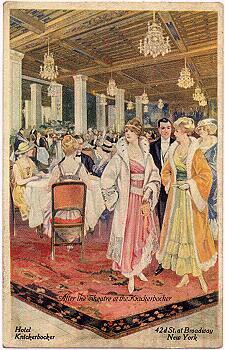Next time you are taking the Times Square Shuttle toward Grand Central, walk toward the northern end of the platform. You’ll find a locked door with the word “Knickerbocker” above it. What could it be? Where does the door go?
Behind the door is a corridor which led up to the rear lobby of the Knickerbocker Hotel at 1466 Broadway, at the southeast corner of 42nd Street. There was a lower level nightclub/dancehall/restaurant. The stair is still there as a relic; underneath the stair is a subway power/communications manhole. Also in back of the wall are sidewalk vaults that belonged to the Knickerbocker.
Newsweek magazine had its headquarters in the building for awhile. By 2014, the Knick was under renovations once again, and it was once again going to be a luxury hotel.

Knickerbocker Hotel in the 1920s
George M. Cohan and Enrico Caruso are among the celebrities who once stayed at the Knickerbocker. It was built in 1901 and has undergone a number of alterations over the years. Its bar was once known as the “42nd Street Country Club.”
The Knickerbocker, “after the theatre”.
The Knickerbocker Hotel entrance was not the only building entrance in the original Times Square station. Befitting the station name, there was a door that led directly to the New York Times Tower (the one now covered in billboards and ringed by the famous “zipper”). The New York Times’ press room was directly below the station and the newspaper noted in 1905 that “it is possible in the early morning hours to load the successive editions on subway cars for the most rapid general distribution” although the paper would remain in the Times Tower for only 8 years.
Soon after, the entrance was bricked up, although the remains of an archway above the door are still evident. ABOVE: Times Tower, center left, early in the 20th Century. It is still standing, although it has now been covered by neon and billboards.
Source: “Crossroads of the Whirl”, David Dunlap, NY Times March 28, 2004
The shuttle station at Grand Central is itself a relic, being part the first real subway line in New York City that was built in 1904. The line ran along today’s 4-5-6 lines north from City Hall , then west along today’s shuttle, then north along Seventh Avenue along today’s 1-2-3 lines. A look from the north end of the shuttle station will reveal that the shuttle tracks do indeed connect with the 1-2-3 there.
Some of Times Square’s original terra-cotta work.
This 7/16/14 NY Times article takes you behind the Knickerbocker door.
5/3/98, rev. 2004, 2014



